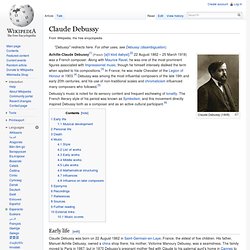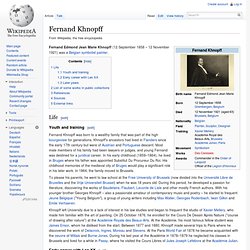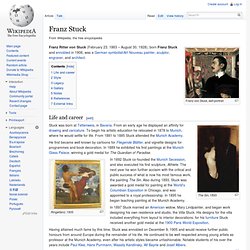

Symbolism - Symbolism Art. Symbolism (Late 19th century) Symbolism originated in France, and was part of a 19th-century movement in which art became infused with mysticism.

French Symbolism was both a continuation of the Romantic tradition and a reaction to the realistic approach of impressionism. It served as a catalyst in the outgrowth of the darker sides of Romanticism and toward abstraction. The term Symbolism means the systematic use of symbols or pictorial conventions to express an allegorical meaning. Symbolism is an important element of most religious arts and reading symbols plays a main role in psychoanalysis. Wassily Kandinsky Prints and Posters at eu. Jackson Pollock. Paul Jackson Pollock (January 28, 1912 – August 11, 1956), known as Jackson Pollock, was an influential American painter and a major figure in the abstract expressionist movement.

He was well known for his unique style of drip painting. During his lifetime, Pollock enjoyed considerable fame and notoriety, a major artist of his generation. Regarded as reclusive, he had a volatile personality, and struggled with alcoholism for most of his life. In 1945, he married the artist Lee Krasner, who became an important influence on his career and on his legacy.[1] Pollock died at the age of 44 in an alcohol-related, single-car accident; he was driving. Jackson Pollock Prints and Posters at eu. Claude Debussy. Claude Debussy (1908) Achille-Claude Debussy[1] (French: [aʃil klod dəbysi];[2] 22 August 1862 – 25 March 1918) was a French composer.

Along with Maurice Ravel, he was one of the most prominent figures associated with Impressionist music, though he himself intensely disliked the term when applied to his compositions.[3] In France, he was made Chevalier of the Legion of Honour in 1903.[4] Debussy was among the most influential composers of the late 19th and early 20th centuries, and his use of non-traditional scales and chromaticism influenced many composers who followed.[5] Fernand Khnopff. Life[edit] Youth and training[edit] Fernand Khnopff was born to a wealthy family that was part of the high bourgeoisie for generations.

Khnopff's ancestors had lived in Flanders since the early 17th century but were of Austrian and Portuguese descent. Most male members of his family had been lawyers or judges, and young Fernand was destined for a juridical career. In his early childhood (1859–1864), he lived in Bruges where his father was appointed Substitut Du Procureur Du Roi. Early career with Les XX[edit] In 1881, he presents his works to the public for the first time at the "Salon de l'Essor" in Brussels. "The Garden" (1886) In 1885, he met the French novelist Joséphin Péladan the future grandmaster of the Rosicrucian "Ordre de la Rose + Croix". Khnopff: The Caress Later years[edit] Portrait of the Artist's Sister Framed Giclee Print by Fernand Khnopff at eu.
Franz Stuck. Franz von Stuck, self-portrait Life and career[edit] The Sin, 1893 Stuck was born at Tettenweis, in Bavaria.

From an early age he displayed an affinity for drawing and caricature. To begin his artistic education he relocated in 1878 to Munich, where he would settle for life. Franz von Stuck 004.jpg - Wikipedia, the free encyclopedia. Jacek Malczewski. Malczewski was born in Radom,[3] part of Congress Poland controlled by the Russian Empire.

During his childhood and early teen years he was greatly influenced by his father Julian, a Polish patriot and social activist who introduced him to the world of Romantic literature inspired by the November Uprising. Similarly, the beauty of Polish landscape and folklore had been awakened in him by Feliks Karczewski, his uncle and long-time guardian who invited future novelist Adolf Dygasiński to his estate, for Jacek's cognitive benefit.[1] Artistic career[edit] Melancholia (1894), National Museum in Poznań Malczewski moved to Kraków at age 17, and began his art education in 1872 under the watchful eye of Leon Piccard.
Malczewski started his master studies with Jan Matejko already in 1875 before embarking on a trip to France, and completed them in 1879 after his return from abroad back to Partitioned Poland. Jacek Malczewski - str. 5. Symbolism (arts) Distinct from, but related to, the style of literature, symbolism of art is related to the gothic component of Romanticism.

The term "symbolism" is derived from the word "symbol" which derives from the Latin symbolum, a symbol of faith, and symbolus, a sign of recognition, in turn from classical Greek συμβόλον symbolon, an object cut in half constituting a sign of recognition when the carriers were able to reassemble the two halves. In ancient Greece, the symbolon, was a shard of pottery which was inscribed and then broken into two pieces which were given to the ambassadors from two allied city states as a record of the alliance. The symbolist poets have a more complex relationship with Parnassianism, a French literary style that immediately preceded it.
While being influenced by hermeticism, allowing freer versification, and rejecting Parnassian clarity and objectivity, it retained Parnassianism's love of word play and concern for the musical qualities of verse. Symbolism - Symbolism Art. Oil Painting Reproduction Studio.